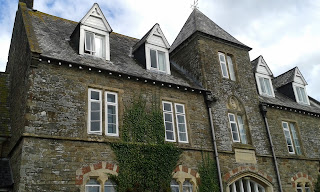All three rivers arise on Plynlimon in mid Wales but the story goes that from there, in their youth, they decided to strike out in different directions. Ystwyth, being lazy, took the shortest route to the sea, setting off to the west; Hafren, who was bold and beautiful and sought the company of men, made her way through towns and villages down to the Bristol Channel. But Varga was shy and retiring - she took the hidden way through quiet hills and secret places to meet up with Hafren at their journey's end. And that to me exemplifies the wonderful Wye Valley - a place of peace and quiet, quite magical to walk.
 |
| Varga - shy and retiring |
Today I was walking my dog down by the Sharpness and Gloucester Canal, another favourite place of mine and about which I'm currently preparing a script for a radio programme on "Walking History". It's only been in recent years that I've appreciated how interesting the stories behind our canals - their origins, their working pasts and their current regeneration - can be. Next week I'm going to a workshop on the Swindon Poetry Festival run by Jo Bell, the Canals Laureate; I'm really looking forward to meeting her and to working on some ideas with her.






